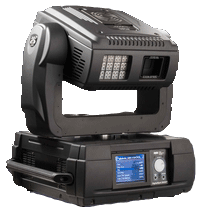Review: The TRX Series, from City Theatrical and Philips Color Kinetics
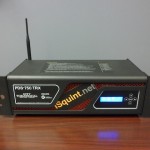 Not long ago, Philips Color Kinetics introduced the next generation of Color Blast’s: The TRX Series. Adding 2 new colors to the standard regimen of Red, Green, and Blue, these new Color Blasts called for a more intelligent power supply. Providing this new backbone is City Theatrical and the new PDS-750 TRX Power and Data Supply. Not one to rest on their laurels, City Theatrical raised the bar with this reinvention of their industry standard PDS. Lets start at the beginning:
Not long ago, Philips Color Kinetics introduced the next generation of Color Blast’s: The TRX Series. Adding 2 new colors to the standard regimen of Red, Green, and Blue, these new Color Blasts called for a more intelligent power supply. Providing this new backbone is City Theatrical and the new PDS-750 TRX Power and Data Supply. Not one to rest on their laurels, City Theatrical raised the bar with this reinvention of their industry standard PDS. Lets start at the beginning:
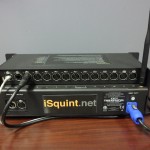 The PDS 750 TRX is housed in a very sturdy, 3U rack mount or pipe mount housing. The front panel has the factory label; a stylish, red air flow grill; and the back-lit LED display and 5 button control interface. On the top of the fixture is a welcome cheat sheet that covers basic setup in all modes. The back panel contains the PowerCon power input and fuse, the 5-Pin DMX In and Out, a USB connection for software updates, a 2-port EtherCon switch, the 12 4-Pin Fixture outputs, and the SHoW DMX wireless antenna. There is also a small hole in the metal casing, presumably for a safety cable if you are pipe mounting the PDS.
The PDS 750 TRX is housed in a very sturdy, 3U rack mount or pipe mount housing. The front panel has the factory label; a stylish, red air flow grill; and the back-lit LED display and 5 button control interface. On the top of the fixture is a welcome cheat sheet that covers basic setup in all modes. The back panel contains the PowerCon power input and fuse, the 5-Pin DMX In and Out, a USB connection for software updates, a 2-port EtherCon switch, the 12 4-Pin Fixture outputs, and the SHoW DMX wireless antenna. There is also a small hole in the metal casing, presumably for a safety cable if you are pipe mounting the PDS.
Control of PDS-750 TRX is available via wired DMX, wireless SHoW DMX, Ethernet (ArtNet, sACN, or Ki-Net) or using one of the on-board programs or static colors. Setup is quick and simple. Plug in your power cord and hook up your fixtures and then using either the on-board setup wizard or the advanced setup menus you can select your method of control. The PDS-750 TRX will run any combination of 2, 3 or 5 color CK fixtures. Using the on-board fixture patch you can actively adapt the fixture’s address’s so that there are no wasted DMX channels as in the past. A nice part about the setup wizard is that it will also identify the types of fixtures connected and ask you what control profile you want to use.
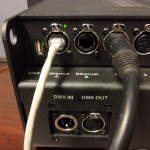 DMX control of the PDS-750 TRX is as simple as connecting a control source to the 5-pin input on the unit. In basic 8-bit mode, the fixtures operate on one channel per color, up to the full 5 colors available in the Color Blast TRX’s. Using my test console (an Elation SDC-6), the Color Blast dimmed smoothly and with a very even curve.
DMX control of the PDS-750 TRX is as simple as connecting a control source to the 5-pin input on the unit. In basic 8-bit mode, the fixtures operate on one channel per color, up to the full 5 colors available in the Color Blast TRX’s. Using my test console (an Elation SDC-6), the Color Blast dimmed smoothly and with a very even curve.
SHoW DMX control allows the PDS to operate wirelessly on any one of 16 different channels (or universes). Using the same test console connected to a standard SHoW DMX indoor transmitter, I had full control of the fixture with zero lag time despite four WiFi networks and Bluetooth scanners also running in the same environment. A feature of note when running SHoW DMX is that the DMX connector on the back of the PDS will output whatever universe the PDS is receiving. This allows you to control the rest of your DMX devices without investing in more receivers. It’s a very nice hat-tip from the folks at CTI.
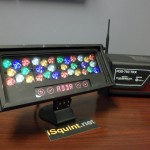 Ethernet control of the PDS was a bit more challenging, but only due to the steps needed to enter the IP address information. You can control the PDS over ArtNet, sACN (think ETCNet 3), or Ki-Net (Color Kinetics Architectural). Having the extra Ethernet port is an excellent add-on that makes daisy chaining multiple PDS units a snap.
Ethernet control of the PDS was a bit more challenging, but only due to the steps needed to enter the IP address information. You can control the PDS over ArtNet, sACN (think ETCNet 3), or Ki-Net (Color Kinetics Architectural). Having the extra Ethernet port is an excellent add-on that makes daisy chaining multiple PDS units a snap.
Not having a sACN source, I setup and configured the PDS for ArtNet control on a static IP address. I then logged into the WiFi network with my iPad and using Alcorn McBride’s LightingPad was able to control the PDS perfectly. There was no lag time and the dimming curves were as smooth as ever. CTI also gives Ethernet control the same hat-tip as SHoW DMX by outputting the same control universe to the DMX port on back.
Not to be outdone, Philips Color Kinetics has taken the next generation Color Blast TRX to the next level. Featuring not just RGB color mixing, CK added Amber and White to the mix. For theatre and Broadway applications, the soft tones that can now be mixed are a most welcome addition. The Color Blast TRX also features a first-ever 4-character LED display and touch sensitive buttons for at-fixture controls. As introduced with the TR, the TRX features both clear and frosted lenses that can be swapped out. The rubber surround is gone and in its place is a CTI accessory holder.
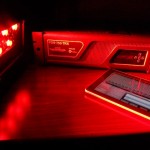 Operation of the on-board control is simple and elegant. Press the two outermost buttons at the same time and the controls unlock for about 60 seconds. You can set the DMX address, fixture profile, set static colors, chases, and run a test mode to name a few functions. The control buttons use the same type of touch sensor glass that many smart phones use. You don’t actually press them, you just tap them. One would imagine this will significantly increase fixture reliability as adding physical contactors adds a mechanical failure point.
Operation of the on-board control is simple and elegant. Press the two outermost buttons at the same time and the controls unlock for about 60 seconds. You can set the DMX address, fixture profile, set static colors, chases, and run a test mode to name a few functions. The control buttons use the same type of touch sensor glass that many smart phones use. You don’t actually press them, you just tap them. One would imagine this will significantly increase fixture reliability as adding physical contactors adds a mechanical failure point.
Overall the color mix and output of the new Color Blast TRX is excellent. However, don’t get rid of your iW Blasts just yet. The amber and white are excellent additions that allow the TRX to mix some amazing new colors. However, the white and amber only output is just not quite bright enough to be effective on its own. Overall though, Philips Color Kinetics has added an excellent new addition to the Color Blast legacy. Combined with City Theatrical’s new PDS-750 TRX, the bar has been set for ease of use and functionality.
 The new TRX technology is available now for purchase and rental from most of your top lighting dealers in the US. To round out the family, CTI also introduced the new PDS-350 TRX (6-channel vs. 12-channel). For more information please visit either City Theatrical or Color Kinetic’s websites.
The new TRX technology is available now for purchase and rental from most of your top lighting dealers in the US. To round out the family, CTI also introduced the new PDS-350 TRX (6-channel vs. 12-channel). For more information please visit either City Theatrical or Color Kinetic’s websites.
PRG Adds iView ArtNet iPhone & iPad App to iTunes Store
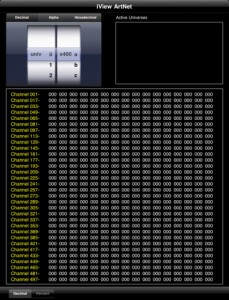 iView ArtNet allows you to view channel levels for Art-Net data that is present on a Wi-Fi network. Note: a Wi-Fi connection is required for this app to work.
iView ArtNet allows you to view channel levels for Art-Net data that is present on a Wi-Fi network. Note: a Wi-Fi connection is required for this app to work.
Active Art-Net universes present on the current Wi-Fi connection are displayed in a list. The universe to be viewed can be selected using decimal, hexadecimal, or alphabetical notation. Additionally you can select the System ID for a PRG Series 400 distribution system (always select System A if not using a Series 400 system). Channel level values can be displayed in decimal or percent format.
iView Art-Net will receive either broadcast or unicast data, but does not respond to ArtPolls. You must manually configure your transmitting device, wireless access point, and iPhone/iPad to ensure proper communication.
What are you waiting for, add iView ArtNet to your iPhone, iPod Touch, iPad NOW! It is a totally FREE APP in the iTunes App store, go grab it now.
Luminair iPhone App Version 1.5 Released
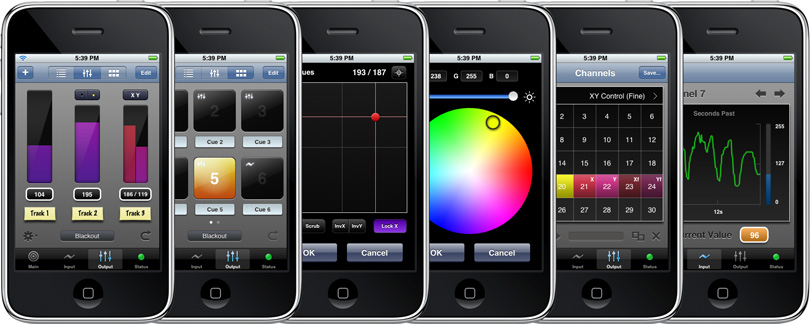
We have been following Synthe FX, the developer of Luminair over the past couple of weeks here at iSquint. We just received the official word, Luminair lighting control iPhone App version 1.5 is released and ready for purchase and download on iTunes. Luminair enables you to wirelessly control, view, record and manage intelligent DMX lighting fixtures, consoles, media servers and other software directly from your iPhone™ or iPod™ touch. Using Artistic License’s Art-Net protocol over your device’s built-in Wi-Fi connection, Luminair communicates with other compatible hardware and software nodes on your network. A gorgeous user interface provides desktop-calibre features and performance, all on a mobile platform. Use Luminair as the ultimate remote focus tool, for advanced architectural lighting, or simply as the centerpiece of your intelligent lighting rig.
More from the Press Release:
Synthe FX has announced the immediate availability of Luminair 1.5 for iPhone™ and iPod® touch. This new version adds over 20 new major features and enhancements which make Luminair the ultimate wireless DMX tool for lighting professionals. Luminair allows users to control, view and manage intelligent DMX lighting fixtures and consoles, directly from an iPhone or iPod touch using the Art-Net protocol over a Wi-Fi connection. It can be used for a wide variety of tasks such as the ultimate remote focus tool, for advanced architectural lighting, by lighting technicians bench-testing fixtures, controlling intensities on set, or simply as the centerpiece of an intelligent lighting rig.
New in version 1.5, users can now create Quick-Touch cues, which provide easy touch based scene triggering. Each Quick-Touch cue has an individual fade time, which can smoothly and seamlessly transition from any currently running fade. Cues are enabled and disabled via large touch-trigger buttons, and arranged in sheets of six at a time. In addition, tracks can be reloaded and edited from each cue for further manipulation via Luminair’s output control tools such as channel faders, color changers, and 16-bit XY controls.
Another major new feature in version 1.5 is the ability to record snapshots of DMX data directly from Luminair’s Art-Net input port. This makes Luminair a great tool for backing up cues from a console or any other DMX source. By storing this data in a Quick-Touch cue, user’s can easily recall scenes from their main console, and even have individual fades between each one.
Other new features include an improved color-picker, improved CMY support, individual blackout and solo controls for each track, a new factory fixture preset library, plus many more. Like all previous updates, this new version also brings performance enhancements and other bug fixes, and is a free update for current users. Also included is a 10% off coupon with Luminair, good towards Enttec’s ODE Art-Net to DMX converters and related accessories, and valid worldwide via Enttec’s online store until June 30, 2009.
“Luminair was the first, and currently still is, the only true native DMX controller for the iPhone and iPod touch”, says company founder Ryan Hisey. “We have made a tremendous effort in bringing these capabilities to the iPhone platform, and in these first eight months the customer response has been phenomenal. Customers worldwide are using Luminair in a wide variety of markets, from theatre and stage, to architectural and studio. The new additions in 1.5 will make it an even more attractive product to a wider variety of users. The fact that there are so many different ways to either integrate Luminair with existing systems, or just use on it’s own, make the possibilities for use almost endless.”
Rumor Mill: Enttec ODE New Firmware in the Works.
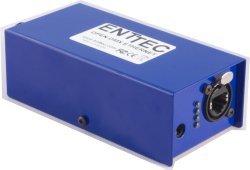 Our tip line is getting filled up with rumors running around the industry these days. The latest rumor that has been sent to us is that Enttec, the makers of lighting control products such as the Open DMX Ethernet (ODE) device pictured left have been developing a firmware upgrade for the ODE.
Our tip line is getting filled up with rumors running around the industry these days. The latest rumor that has been sent to us is that Enttec, the makers of lighting control products such as the Open DMX Ethernet (ODE) device pictured left have been developing a firmware upgrade for the ODE.
The current model of the ODE supports 1 universe of DMX over Art-Net and ESP. The firmware upgrade would merge up to 8 art-net streams coming from different IP addresses of any origin to make the ODE a 8:1 merger of Art-Net data.
The firmware upgrade is still in beta testing and not available just yet. The firmware upgrade i for the first 2 universes is a free firmware upgrade. The additional 6 universes would be available though a paid for firmware upgrade through Enttec. This would give a total of 8 HTP Art-net inputs for an ODE.
to learn more about the Enttec Open DMX Ethernet (ODE) device, or to purchase your open, visit Enttec’s website at www.enttec.com.
Review: Enttec E-Streamer
 The Enttec E-Streamer is a rack mountable show server for entertainment and the architectural world. One huge draw to the E-Streamer is that it can handle up to 64 universes. It is recommended that if you are using fully populated universes, you limit yourself to 40 per unit if you are running on a 100Mbit network. While the E-Streamer has no problem sending 64 universes of data out on 100Mbit network, there can be bottle necks and packet loses due to less expensive routers. It is recommended to have a professional network administrator setup a high-end router to handle this amount of data through unicasting rather then broadcasting. Additionally, it has a swappable hard drive so if you have multiple units in multiple locations running the same show you can just copy all of the files to a hard drive, take them with you, upload them to the new unit and be on your way. It also boasts a processor beefy enough to allow you to run up to 100 simultaneous shows using any or all of the universes (any channels that are affected by multiple shows simultaneously are treated in an HTP manner). Events or start of shows can be triggered via the internal time clock, buttons on the face of the unit, RS232 commands, or network triggers, and is perfectly content sitting in a network rack running the same shows for years on end.
The Enttec E-Streamer is a rack mountable show server for entertainment and the architectural world. One huge draw to the E-Streamer is that it can handle up to 64 universes. It is recommended that if you are using fully populated universes, you limit yourself to 40 per unit if you are running on a 100Mbit network. While the E-Streamer has no problem sending 64 universes of data out on 100Mbit network, there can be bottle necks and packet loses due to less expensive routers. It is recommended to have a professional network administrator setup a high-end router to handle this amount of data through unicasting rather then broadcasting. Additionally, it has a swappable hard drive so if you have multiple units in multiple locations running the same show you can just copy all of the files to a hard drive, take them with you, upload them to the new unit and be on your way. It also boasts a processor beefy enough to allow you to run up to 100 simultaneous shows using any or all of the universes (any channels that are affected by multiple shows simultaneously are treated in an HTP manner). Events or start of shows can be triggered via the internal time clock, buttons on the face of the unit, RS232 commands, or network triggers, and is perfectly content sitting in a network rack running the same shows for years on end.
There are some caveats to this powerful machine. The biggest one is that the only way to get data in or out of the machine is through its Ethernet port, so you have to figure out some way to turn your 5 Pin DMX into an Ethernet based protocol. Conveniently enough, Enttec makes several boxes that can help you do this. The simplest is the ODE (Open DMX over Ethernet) which has male and female 5 pin XLR connectors on one side and a female Ethernet jack on the other. This tends to work out well for large architectural installations, if you have several sites that are separated from your control point it’s easier and cheaper for your Electrical Contractor to convert your DMX to Ethernet at each site and run Ethernet back to a switch near your E-Streamer (keeping in mind of course that the run limit for Ethernet is 100m before it has to be boosted). If, on the other hand, running the DMX makes more sense, Enttec also makes a Datagate which is a fully configurable Ethernet to DMX Splitter/Switch which has 8, 5 pin XLR connectors and an RJ45 jack on its face.
The E-Streamer is exclusively a streamer and not well suited for programing directly within. There is no way to program your shows using it as a standalone unit. An external console is necessary to program the lights, and once you have everything looking the way you want it just run the DMX through the streamer and record your cue stacks as shows. For large jobs, this is probably the preferred method for using the E-Streamer. If you are programming an E-Streamer project that is actually using anywhere near 64 universes you can have multiple programmers working on different sections with different consoles simultaneously because of the networked nature of the beast. Just don’t forget, you’re going to need some way to get the DMX out from the console into the E-Streamer.
Enttec is coming up with a lot of interesting control solutions that could be very helpful in the architectural and architainment markets. The E-Streamer is one of a number of powerful tools they have in their arsenal. For the right situation this box can be a life saver. For more information on the Enttec E-Streamer, visit their website at www.enttec.com. Contact your local Enttec dealer for pricing.
Enttect will be demonstrating the E-Streamer and other control products they offer this week at USITT in a shared booth with Stage Research, #1040.
Robe: DigitalSpot 7000DT & 3000DT
Robe Lighting introduced two new lighting fixtures at LDI this year in Las Vegas, the DigialSpot 7000DT and the DigitalSpot 3000DT. Both of these fixtures are Digital projection luminaries that not only project video images, but function as light instruments. Robe jump head first into the digital projection market with these fixtures and touted at their booth at LDI that digital projection is the way of the future and is here and ready.
DigitalSpot 3000DT
Robe’s DigitalSpot 300DT is their first Digital Moving Light Projector that combines their REDWash (Robe Emitted Diodes) LED module and Digital Projector to create a fixture that is able not only to wash with a large amount of color choices, but also use projections. The 3000DT emits 2.700 Ansi lumens from a single 200W projection lamp with a contrast ratio of 2,000:1. The lamp is rated at 4,000 lamp hours and has an aspect ratio of 4:3 with an XGA resolution of 1,024×768 and can produce a full 16.7 million color palette. The DigitalSpot 3000DT in a single Road Case retails for $19,900. Learn more about the DigitalSpot 3000DT visit the product page at www.robelighting.com
DigitalSpot 7000DT
The DigitalSpot 7000DT is the second offering from Robe Lighting and offers a high output in lumens for digital projections. The 7000DT uses a 330W lamp and emit 6,500 ANSI lumens with a contrast ratio of 2,000:1. Each of the two LED modules use 48 Luxeon Rebel RDBW LED’s.
The 7000DT offers both DVI and SDI input/outputs to make getting video in and out of the fixture easy and efficiently with out having to worry about different connector or video signal requirements.
The 7000DT also offers web access through the fixture to provide total control and configuration of the fixture with user library management. To learn more about the DigitalSpot 700DT, visit the product page at www.robelighting.com.
Both fixtures offer some of the standard features such as:
- 5″ TFT LCD display & Robe navigation system
- Communication with active RDM running ROBE RDMNet
- Pan movement range of 530°
- Tilt movement range of 280°
- 16 bit movement resolution
- DMX data in/out, locking 3-pin & 5-pin XLR
- 2 USB 2.0 connectors
- ArtNet: RJ45
- 4 Digital Gobo Layers for Image and Video Control
- Picture Merging effect in the field of up to 8×8 segments
- Projection onto spherical surfaces, cylindrical surfaces and angular screens
- Layer Media Control Modes (Copy, Add, Subtract, Multi, Minimum and Maximum)
- Framing Shutter Effect for creating action scripts for Images or Videos
- Digital Iris effect + 160 Masking effects
- Full digital keystone correction facilities
- Digital Strobe effect
- CMY Image and Video Colour Mixing, plus CTC (Colour Temperature Correction)
- PC or Laptop VGA or S-Video input for presentations
- Composite video or S-Video input for the onboard Graphics Engine
- DVI Input, SDI Input/output for professional Graphics Engine II
- 2 Effects Engines per Layer
- Effect synchronization
- Gobo (Image) Control Modes
LatestHeadlines
- Upgrading Your Toolbox: City Theatrical DMXcat-E and DMXcat Multi Function Test Tool
- Claypaky Bringing Back the Sexy to Par Cans with the Midi-B FX
- Ayrton Evolves the Cobra, the Cobra2 Developed for the US Market
- MA Lighting Intros grandMA3 onPC Fader Wing and DIN-Rail Nodes
- Live Events LEVL Up Fest: A Festival to Aid our Industry
